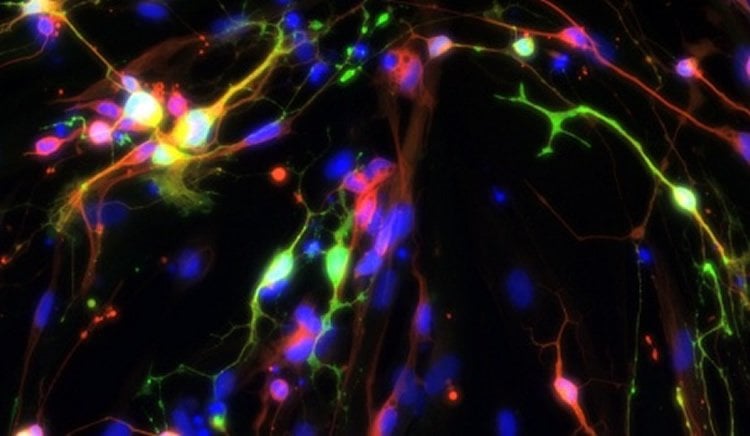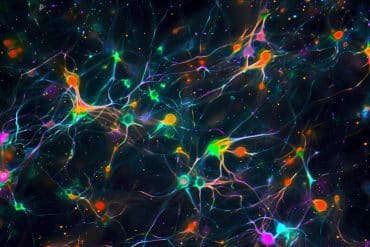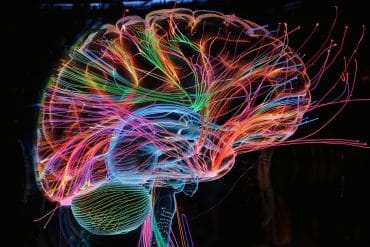The advance could facilitate the discovery of new antidepressants and drugs for illnesses involving serotonin.
Serotonin, a neurotransmitter involved in regulating mood and mental states, has been linked to numerous neurological and mental illnesses, including depression. But because there has been no way to obtain live human serotonin neurons to study these diseases, most serotonin research has been done on lab animals.
Now, University at Buffalo researchers have generated human serotonin neurons from human fibroblasts, the cells that give rise to connective tissue in the body.
The researchers say that their findings are applicable to generating many other previously inaccessible human cell types, providing a boon to medical research and drug discovery.
“Our work demonstrates that the precious serotonin neurons hidden deep inside the human brain can now be created in a petri dish,” said lead author Jian Feng, PhD, professor in the Department of Physiology and Biophysics in the UB School of Medicine and Biomedical Sciences. Feng also has an appointment at the Veterans Affairs Western New York Healthcare System in Buffalo.
The paper was published online on July 28. A future issue of the print journal will feature an image from the UB research on the cover. The work builds on previous studies showing that human fibroblasts can be converted to neurons, using specialized transcription factors that bind to genes, turning them on or off.
Generating serotonin neurons
The UB research demonstrates the first direct conversion of human fibroblasts into serotonergic neurons, Feng said. These “induced serotonergic neurons” behave like serotonin neurons in the human brain.
“We know the cells were converted to serotonergic neurons because they express proteins that are only found in neurons that produce serotonin,” Feng explained. “They are electrophysiologically active and demonstrate both the controlled release and the selective uptake of serotonin.”
The researchers found that they could produce induced serotonergic neurons from fibroblasts by introducing four genes that control the development of serotonin neurons. “These genes change how the human genome, which is like a computer hard drive, is read, so that the cell switches from a lung cell to a serotonin neuron,” said Feng.
“With this new technology, scientists can generate serotonin neurons from patients who suffer from serotonin-related mental illnesses,” said Feng.

While the paper focuses on converting lung fibroblasts to serotonin neurons, Feng’s group at UB also has been working on generating serotonin neurons from human skin cells, which would be an even easier and less invasive process.
A versatile technology
Such induced serotonin neurons would be extremely beneficial since they can be generated from individual patients suffering from illnesses involving the neurotransmitter.
“These patient-specific serotonin neurons will be very useful to the discovery of new drugs for diseases ranging from depression and anxiety to obsessive-compulsive disorder and many others,” said Feng. “They will not only allow researchers to study why certain individuals develop a disease but also to find out what can be done to treat it.”
Feng is optimistic that the same technology is versatile enough that it can be used to generate other new cells and tissues: “This research shows that it is possible to convert one type of cell into other types that have been difficult to access, such as neurons or heart cells,” he said. “All we need to do is find out the combination of transcription factors that is necessary. Sooner or later, we will find out what those combinations are so that we can regenerate cells and eventually tissues that will mimic the real cells and tissues in the body.”
Feng’s UB co-authors are Zhen Yan, PhD, professor, and Ping Zhong, PhD and Houbo Jiang, PhD, both research assistant professors, all in the Department of Physiology and Biophysics. Other co-authors are Zhimin Xu and Shengdi Chen, both of Ruijin Hospital and Shanghai Jiao Tong University School of Medicine.
Funding: The work was supported by grants from the National Key Basic Research Program of China, the National Natural Science Foundation of China, the U.S. Department of Veterans Affairs, NYSTEM and the National Institutes of Health.
Source: Ellen Goldbaum – University at Buffalo
Image Credit: The image is credited to Jian Feng, UB
Original Research: Full open access research for “Direct conversion of human fibroblasts to induced serotonergic neurons” by Z Xu, H Jiang, P Zhong, Z Yan, S Chen and J Feng in Molecular Psychiatry. Published online July 28 2015 doi:10.1038/mp.2015.101
Abstract
Direct conversion of human fibroblasts to induced serotonergic neurons
Serotonergic (5HT) neurons exert diverse and widespread functions in the brain. Dysfunction of the serotonergic system gives rise to a variety of mental illnesses including depression, anxiety, obsessive compulsive disorder, autism and eating disorders. Here we show that human primary fibroblasts were directly converted to induced serotonergic (i5HT) neurons by the expression of Ascl1, Foxa2, Lmx1b and FEV. The transdifferentiation was enhanced by p53 knockdown and appropriate culture conditions including hypoxia. The i5HT neurons expressed markers for mature serotonergic neurons, had Ca2+-dependent 5HT release and selective 5HT uptake, exhibited spontaneous action potentials and spontaneous excitatory postsynaptic currents. Application of serotonin significantly increased the firing rate of spontaneous action potentials, demonstrating the functional utility of i5HT neurons for studying serotonergic neurotransmission. The availability of human i5HT neurons will be very useful for research and drug discovery on many serotonin-related mental disorders.
“Direct conversion of human fibroblasts to induced serotonergic neurons” by Z Xu, H Jiang, P Zhong, Z Yan, S Chen and J Feng in Molecular Psychiatry. Published online July 28 2015 doi:10.1038/mp.2015.101






